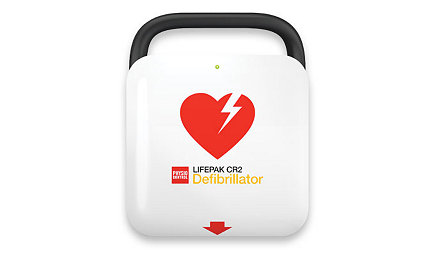AED pad placement guide
24-Sep-2024

4-minute read
Where to place AED pads on adults and children
In the critical moments of a sudden cardiac arrest, the proper use of an automated external defibrillator (AED) can help determine the outcome of the event. When the heart unexpectedly falls into a shockable rhythm, an AED becomes an invaluable tool to provide an opportunity to restore an organized rhythm. However, the effectiveness of this life-saving device is heavily contingent upon the correct placement of its pads on the patient’s body.1
The pads must be positioned correctly precisely to help ensure the electrical current passes through the heart muscle effectively. Clear visual cues and instructions as well as voice prompts typically accompany an AED, guiding even an untrained bystander through the process.
Anterior-lateral placement of AED pads
When employing the anterior-lateral placement, one pad should be positioned on the right side of the patient's chest, specifically beneath the clavicle, or collarbone.
The corresponding pad is then placed on the left side of the patient’s chest. It is situated below the level of the pectoral muscles, carefully avoiding the breast tissue.

Anterior-posterior placement of AED pads
While the standard positioning of AED pads is typically lateral, with one pad placed to the right of the sternum and the other below the left breast, there are certain clinical scenarios where an anterior-posterior configuration is advantageous. This alternative method involves positioning one pad on the chest (anterior), while the corresponding pad is adhered to the back (posterior), directly behind the first pad.
This placement is also helpful when a patient has a medical implant such as a pacemaker or implantable cardioverter-defibrillator, which might be damaged by electrical shock or divert energy from the heart.

Pad placement on children
When it comes to AED pad placement on adults, the anterior-lateral position is the standard. However, for children under the age of 8 or weighing less than 55 pounds (25 kilograms), special considerations are needed.
If available, use pediatric pads and an AED with a pediatric dose attenuator.
For young children with small chests, use the anterior-posterior pad placement method. Place one pad in the center of the chest and the other on the back between the shoulder blades. Using pads with the anterior-posterior placement method ensures that the pads do not overlap or touch each other.

The Importance of correct AED pad placement
Correct pad placement is needed for several reasons:
- Maximizes the effectiveness of the shock delivered to the heart. Proper placement of the pads helps ensure the electrical current follows the most direct path through the heart. This helps maximize the chance of restoring a normal heart rhythm.2
- Reduces the risk of burns under the pads. Correct pad placement on dry skin can help minimize the risk of skin burns. Moisture can reduce the adhesion of pads to the chest wall and negatively affect the effectiveness of the AED shocks, potentially causing burns when the shock is delivered.3
- Protects the safety of the rescuer and bystanders. By following the recommended pad placement guidelines, rescuers reduce the risk of an accidental shock to themselves or bystanders.4
Together, we save lives.
The correct placement of AED pads is a critical component of effective defibrillation. Whether it's the anterior-lateral or anterior-posterior method, understanding the proper techniques for both adults and children can increase the chances of survival in sudden cardiac emergencies.
AEDs are designed with simplicity in mind to empower anyone to be a lifesaver. Stryker’s line of AEDs offers several options to best suit your needs. With more than a million AEDs deployed globally, Stryker offers diverse options and deep expertise to help you choose the right device and cost-effectively manage your AED program.
Connect with an AED expert to learn more about our AEDs and how we can help make your community safer.
FAQs
New AEDs can cost anywhere from $1,200 to $3,000 depending on features.
Yes, but dry the chest area before applying the pads. Water can conduct electricity, creating a risk of shock to the rescuer or bystanders.
Related
AED buying guide
An effective AED program is a critical link in the chain of survival, empowering you to deliver lifesaving intervention even before emergency services arrive. Stryker offers diverse options to help you choose the right defibrillator for your employees and customers.
Learn moreKnowing when to use an AED: CPR and AED guidelines for sudden cardiac arrest
When to use an AED is crucial in sudden cardiac arrest situations. Learn how to recognize sudden cardiac arrest symptoms and act promptly to help increase the chance of survival.
Learn moreLIFEPAK CR2 defibrillator
The LIFEPAK CR2 AED response system empowers bystanders to help save lives. Innovative, easy-to-operate technology allows continuous CPR and helps streamline communication across the system of care.
Learn more1. Esibov, A., Chapman, F. W., Melnick, S. B., Sullivan, J. L., & Walcott, G. P. (2016). Minor Variations in Electrode Pad Placement Impact Defibrillation Success. Prehospital emergency care, 20(2), 292–298. https://doi.org/10.3109/10903127.2015.1076095
2. https://www.mycprcertificationonline.com/courses/aed/usage
3. https://www.myheart.org.sg/techniques/aed-pad-placement/
4. David R. Lowery, MD, FASA, Maj, MC, USA, Daniel Cantillon, MD, FACC, FHRS and Donn Marciniak, MD Cleveland Clinic Journal of Medicine January 2020, 87 (1) 16-18; DOI: https://doi.org/10.3949/ccjm.87a.19022
EC-GSNPS-COMM-1210622_REV-0_en_us



